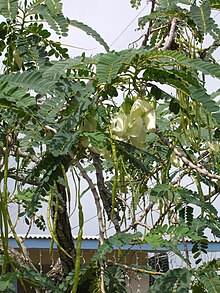Sesbania grandiflora
| Sesbania grandiflora | |
|---|---|
 |
|
| Scientific classification | |
| Kingdom: | Plantae |
| (unranked): | Angiosperms |
| (unranked): | Eudicots |
| (unranked): | Rosids |
| Order: | Fabales |
| Family: | Fabaceae |
| Genus: | Sesbania |
| Species: | S. grandiflora |
| Binomial name | |
|
Sesbania grandiflora (L.) Poiret |
|
| Synonyms | |
|
|
| Nutritional value per 100 g (3.5 oz) | |
|---|---|
| Energy | 113 kJ (27 kcal) |
|
6.73 g
|
|
|
0.04 g
|
|
|
1.28 g
|
|
| Vitamins | |
| Thiamine (B1) |
(7%)
0.083 mg |
| Riboflavin (B2) |
(7%)
0.081 mg |
| Niacin (B3) |
(3%)
0.43 mg |
| Folate (B9) |
(26%)
102 μg |
| Vitamin C |
(88%)
73 mg |
| Minerals | |
| Calcium |
(2%)
19 mg |
| Iron |
(6%)
0.84 mg |
| Magnesium |
(3%)
12 mg |
| Phosphorus |
(4%)
30 mg |
| Potassium |
(4%)
184 mg |
|
|
|
|
|
| Percentages are roughly approximated using US recommendations for adults. Source: USDA Nutrient Database |
|
Sesbania grandiflora (syn. Aeschynomene grandiflora, Agati grandiflora) (Tamil: அகத்திக்கீரை) also known as vegetable hummingbird,agati or hummingbird tree, is a small tree in the genus Sesbania.
It is a fast-growing tree, leaves are regular and rounded and the flowers white and red in color according to its species. The fruits look like flat, long and thin green beans. The tree thrives under full exposure to sunshine and is extremely frost sensitive.
It is a small soft wooded tree up to 3–8 m, leaves 15–30 cm long; leaflets 10–20 pairs or more and an odd one. Oblong, 1.5–3.5 cm long variety red, 7.5–10 cm long in lax, 2–4 flower racemes, calyx campanulate, shallowly 2-lipped. Pods slender, falcate or straight, 30–45 cm long, suture thick, Seeds ca. 30, to 8 mm.
Indigenous from Malaysia to North Australia; cultivated in many parts of India and Sri Lanka. It has a large number of traditional uses. It grows where there is good soil and hot, humid temperature. Will die in snowy or cold weather, fully tropical plant.
It contains essential amino acids such as arginine, cysteine, histidine, isoleucine, phenylalanine, tryptophan, valine, threonine, alanine, aspargine and aspartic acid. It is also a rich source of fatty acids such as oleanolic acid and linolenic acid. The plant contains various proportions of sugars such as galactose and rhamnose.
The leaf extract is found to inhibit the formation of advanced glycation end-products . The leaf extract is found to contain linolenic acid, aspartic acid, which were found to be the major compounds responsible for the anti-glycation potential of the leaf extract. Leaves used as tonic, diuretic, laxative, antipyretic, chewed to disinfect mouth and throat. Flower in headache, dimness of vision, Catarrh, Headache, cooling and improving appetite, bitter, astringent, acrid, antipyretic. Bark is used for cooling (ayurvedha and siddha medicinal terms), bitter tonic, anthelmintic, febrifuge, diarrhea, smallpox, astringent.Fruits in Bitter and acrid, laxative, fever, pain, bronchitis, anemia, tumors, colic, jaundice, poisoning. Root used in Rheumatism, Expectorant, Painful swelling, Catarrh.
The flowers of S. grandiflora are eaten as a vegetable in Southeast Asia, like Laos, Thailand, Java in Indonesia, Vietnam, and the Ilocos Region of the Philippines.
...
Wikipedia
